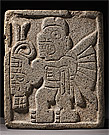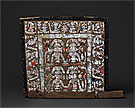Curriculum links History
The history of Peru spans several millennia, extending back through several stages of cultural development in the mountain region and the coastal desert. Items such as tools, indicating human habitation dating back more than 11,000 years have been found by archaeologists during excavations.
Peru is perhaps best known for the Incan empire, but it was home to many diverse Indigenous cultures long before the Incas arrived. Many of these cultures are explored through the exhibition Gold and the Incas: Lost worlds of Peru.The Gold and the Incas: Lost worlds of Peru exhibition has strong links with a number of content descriptions across the year 7 and 8 bands of the Australian Curriculum:
- History
The Gold and the Incas: Lost worlds of Peru secondary school online resource focuses on specialisations within the subject's two strands:
- Historical skills strand
- Historical knowledge and understanding strand
FOCUS: YEAR 7
Historical Knowledge and Understanding/Investigating the ancient past/Investigating the ancient past
Relevant content descriptions:
- How historians and archaeologists investigate history, including excavation and archival research (ACDSEH001)
- The range of sources that can be used in an historical investigation, including archaeological and written sources (ACDSEH029)
- The methods and sources used to investigate at least ONE historical controversy or mystery that has challenged historians or archaeologists, such as in the analysis of unidentified human remains (ACDSEH030)
- The importance of conserving the remains of the ancient past, including the heritage of Aboriginal and Torres Strait Islander Peoples (ACDSEH148)
Historical skills
In a curriculum connection resource that includes year 7 history content, there could be worthwhile opportunities for students to develop or enhance the following specific skills:
- Sequence historical events, developments and periods: identifying the approximate beginning and end dates of ancient societies and the periods of time when they coexisted (ACHHS205)
- Use historical terms and concepts (ACHHS206)
- Identify a range of questions about the past to inform a historical inquiry (ACHHS207)
- Identify the origin and purpose of primary and secondary sources (ACHHS209)
- Develop texts, particularly descriptions and explanations that use evidence from a range of sources that are acknowledged (ACHHS213)
Key questions and investigation opportunities:
- How do we know about the ancient past?
- Why and where did the earliest societies develop?
- What emerged as the defining characteristics of ancient societies?
- What have been the legacies of ancient societies?
- Explore the evidence for the emergence and establishment of ancient societies (including art, iconography, writing tools and pottery)
FOCUS: YEAR 8
Historical Knowledge and Understanding/Expanding contacts/The Spanish Conquest of the Americas (c.1492 – c.1572)
Most relevant content description:
- Pre-Columbian life in the Americas, including social organisation, city life and beliefs (ACDSEH016)
Historical skills
In a curriculum connection resource that includes the Spanish Conquest of the Americas optional depth study in year 8 history, there would be worthwhile opportunities for students to develop or enhance the following specific skills:
- Sequence historical events, developments and periods: identifying the approximate beginning and end dates of ancient societies and the periods of time when they coexisted (ACHHS148)
- Use historical terms and concepts (ACHHS149)
- Identify a range of questions about the past to inform a historical inquiry (ACHHS150)
- Identify the origin and purpose of primary and secondary sources (ACHHS152)
- Develop texts, particularly descriptions and explanations that use evidence from a range of sources that are acknowledged (ACHHS156)
Key inquiry questions:
- How did societies change from the end of the ancient period to the beginning of the modern age?
- What key beliefs and values emerged and how did they influence societies
- What were the causes and effects of contact between societies in this period?
- Which significant people, groups and ideas from this period have influenced the world today?
- Read the Guardian article by Kim MacQuarrie about a fifteen year old girl whose body was found by archaeologists in 1999 and is now on display in a museum in Argentina. How did Andean culture support sacrificial rituals and why did the Inca continue these traditions even though they are considered to be a sophisticated culture?
- Explore the role of women in Andean society. Research works of art in the Gold and the Incas: Lost worlds of Peru exhibition that reference women and discuss how the recent discovery of the tomb of the Lady of Cao helps us to understand more about women in Andean society.
- Research some of the conservation aspects of preserving the past. Investigate techniques such as carbon dating, and think about some of the ethical considerations around mummies and the display of human remains.
- Using a range of primary and secondary sources, research two cultures that are represented in the Gold and the Incas: Lost worlds of Peru exhibition. How were these cultures different and how were they similar? How did they change over time?
- Choose three objects from the Gold and the Incas: Lost worlds of Peru exhibition and discuss how they demonstrate the key beliefs and values of their society.
- Investigate the impact of the Spanish invasion on Incan society and research its influence on contemporary Peruvian culture.
- Investigate the history of peanut production in Peru. Why was the peanut such a symbolic food for Andean peoples? Read more about the objects that were buried with the Lord of Sipán including a spectacular gold and silver bead peanut shell necklace.
- What other foods were important in the diets of ancient Peruvian peoples and how did they benefit the health of the people?
- Irrigation was essential to food production in ancient Peru. To find out more visit the Gold and the Incas: Lost worlds of Peru Geography inline resource
- Conservation alert!
- Read the catalogue entry on the National Gallery of Australia’s Chimú mask (catalogue 148) and learn how the original maize kernels have been preserved in the mask to allow viewing when the object is not on display.
- Interesting extras!









![| Unku [Tunic] | 1400-1533 AD](images/sml/236005.jpg)
![| Tumi [Sacrifical knife] | 750-1375 AD](images/sml/236015.jpg)